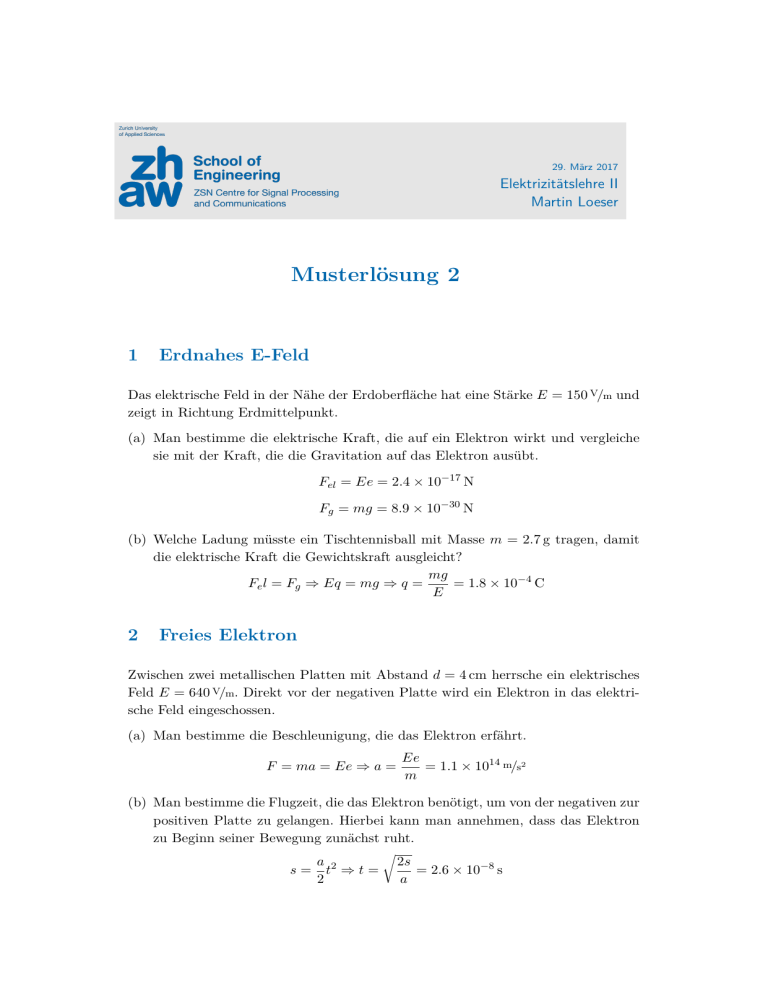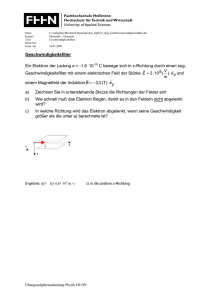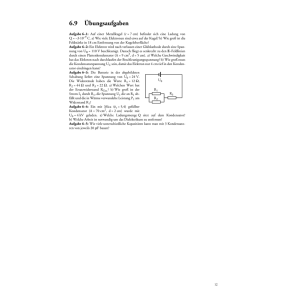¨Ubung 2
Werbung

29. März 2017 Elektrizitätslehre II Martin Loeser Musterlösung 2 1 Erdnahes E-Feld Das elektrische Feld in der Nähe der Erdoberfläche hat eine Stärke E = 150 V/m und zeigt in Richtung Erdmittelpunkt. (a) Man bestimme die elektrische Kraft, die auf ein Elektron wirkt und vergleiche sie mit der Kraft, die die Gravitation auf das Elektron ausübt. Fel = Ee = 2.4 × 10−17 N Fg = mg = 8.9 × 10−30 N (b) Welche Ladung müsste ein Tischtennisball mit Masse m = 2.7 g tragen, damit die elektrische Kraft die Gewichtskraft ausgleicht? mg = 1.8 × 10−4 C Fe l = Fg ⇒ Eq = mg ⇒ q = E 2 Freies Elektron Zwischen zwei metallischen Platten mit Abstand d = 4 cm herrsche ein elektrisches Feld E = 640 V/m. Direkt vor der negativen Platte wird ein Elektron in das elektrische Feld eingeschossen. (a) Man bestimme die Beschleunigung, die das Elektron erfährt. F = ma = Ee ⇒ a = Ee = 1.1 × 1014 m/s2 m (b) Man bestimme die Flugzeit, die das Elektron benötigt, um von der negativen zur positiven Platte zu gelangen. Hierbei kann man annehmen, dass das Elektron zu Beginn seiner Bewegung zunächst ruht. a s = t2 ⇒ t = 2 r 2s = 2.6 × 10−8 s a d that the r create at the 5.00-nC charge. 3q 4q a Figure P23.19 Musterlösung 2 , Elektrizitätslehre II 2 nents of the electric field at point (x, y) due to this charge q are (c) Mit welcher Geschwindigkeit trifft das Elektron auf die positive Platte? 6.00 nC k q(x " x ) x Ekin 3 Dipol Ey % on the x axis. t x % " 1.00 m. y axis at y % e on a " 3.00-!C 0 m. f a square of side mine the magniat the location of e on q? ted at point x and y compo- k e q(y " y 0 ) [(x " x 0 )2 # (y " y 0 )2]3/2 21. Consider the electric dipole shown in Figure P23.21. Wie in derShow Abbildung dargestellt, besteht Dipol point aus einer positiven that the electric field at ein a distant along the Ladung q 3 am Ort x1 x=axis a und is Eeiner 4k e qa /x .Ladung −q am Ort x2 = −a. x ! negativen e corners of an n Figure P23.17. ther create an nt (other than t: Sketch the (b) What are ctric field at P + q s e 0 1 2eEd 2 6 2 2]3/2 = 3.0 × 10 m/s = Epot E⇒x %mv = eU = eEd ⇒ v= [(x " x ) # (y " y ) 0 0 2 m y –q q x 2a Figure P23.21 Abbildung 1: Dipol, bestehend aus zwei Ladungen. 22. Consider n equal positive point charges each of magni- (a) Man bestimme Betrag und Richtung des elektrischen Feldes für einen Punkt, tude Q /n placed symmetrically around a circle of rader in Höhe h auf der y-Achse liegt. dius R. (a) Calculate the magnitude of the electric field (b) Was für Gesetzmässigkeit manline für passing h a? through the E eine at a point a distance erhält x on the center of the circle and perpendicular to the plane of Aus der letzten Übung wissen wir the circle. (b) Explain why this result is identical to the ! one obtained in Example 23.8. q −2a ~ E(h) = √ 23. Consider an infinite number identical 0 charges (each 23 4π0 a2of +h of charge q) placed along the x axis at distances a, 2a, Für h a3a, wissen wir a2 + h2 ≈ h2 – probieren Sie es aus für a = 1 und h = 10. √ 4a, . . . from the origin. What is the electric field 2 + h2 ≈ h. Dann gilt atathe origin due to this distribution?!Hint: Use the fact −2a q that ~ . E(h) ≈ 4π0 h3 0 1 &2 1 1 1# #der2dritten # 2 Potenz # $$ $ des % Abstands, nicht, wie bisher Das elektrische Feld fällt jetzt 2mit 2 3 4 6 gewohnt, mit der zweiten. Section 23.5 Electric Field of a Continuous Charge Distribution 24. A rod 14.0 cm long is uniformly charged and has a total charge of " 22.0 !C. Determine the magnitude and direction of the electric field along the axis of the rod at a point 36.0 cm from its center.

